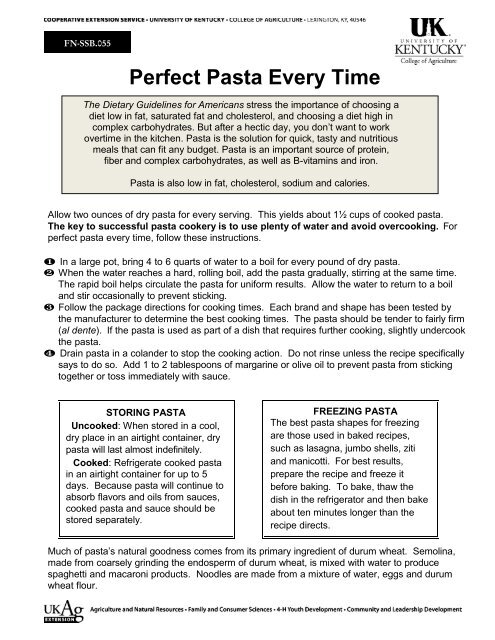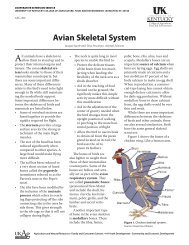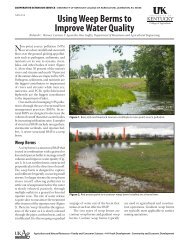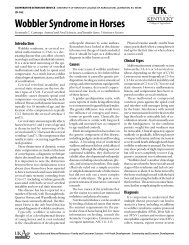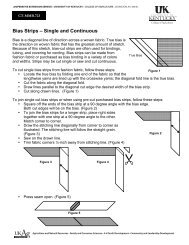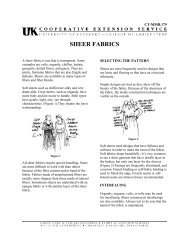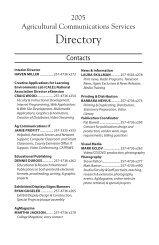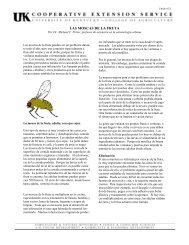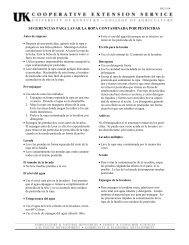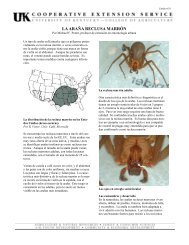Perfect Pasta Every Time - University of Kentucky
Perfect Pasta Every Time - University of Kentucky
Perfect Pasta Every Time - University of Kentucky
Create successful ePaper yourself
Turn your PDF publications into a flip-book with our unique Google optimized e-Paper software.
FN-SSB.055<br />
<strong>Perfect</strong> <strong>Pasta</strong> <strong>Every</strong> <strong>Time</strong><br />
The Dietary Guidelines for Americans stress the importance <strong>of</strong> choosing a<br />
diet low in fat, saturated fat and cholesterol, and choosing a diet high in<br />
complex carbohydrates. But after a hectic day, you don’t want to work<br />
overtime in the kitchen. <strong>Pasta</strong> is the solution for quick, tasty and nutritious<br />
meals that can fit any budget. <strong>Pasta</strong> is an important source <strong>of</strong> protein,<br />
fiber and complex carbohydrates, as well as B-vitamins and iron.<br />
<strong>Pasta</strong> is also low in fat, cholesterol, sodium and calories.<br />
Allow two ounces <strong>of</strong> dry pasta for every serving. This yields about 1½ cups <strong>of</strong> cooked pasta.<br />
The key to successful pasta cookery is to use plenty <strong>of</strong> water and avoid overcooking. For<br />
perfect pasta every time, follow these instructions.<br />
In a large pot, bring 4 to 6 quarts <strong>of</strong> water to a boil for every pound <strong>of</strong> dry pasta.<br />
When the water reaches a hard, rolling boil, add the pasta gradually, stirring at the same time.<br />
The rapid boil helps circulate the pasta for uniform results. Allow the water to return to a boil<br />
and stir occasionally to prevent sticking.<br />
Follow the package directions for cooking times. Each brand and shape has been tested by<br />
the manufacturer to determine the best cooking times. The pasta should be tender to fairly firm<br />
(al dente). If the pasta is used as part <strong>of</strong> a dish that requires further cooking, slightly undercook<br />
the pasta.<br />
Drain pasta in a colander to stop the cooking action. Do not rinse unless the recipe specifically<br />
says to do so. Add 1 to 2 tablespoons <strong>of</strong> margarine or olive oil to prevent pasta from sticking<br />
together or toss immediately with sauce.<br />
STORING PASTA<br />
Uncooked: When stored in a cool,<br />
dry place in an airtight container, dry<br />
pasta will last almost indefinitely.<br />
Cooked: Refrigerate cooked pasta<br />
in an airtight container for up to 5<br />
days. Because pasta will continue to<br />
absorb flavors and oils from sauces,<br />
cooked pasta and sauce should be<br />
stored separately.<br />
FREEZING PASTA<br />
The best pasta shapes for freezing<br />
are those used in baked recipes,<br />
such as lasagna, jumbo shells, ziti<br />
and manicotti. For best results,<br />
prepare the recipe and freeze it<br />
before baking. To bake, thaw the<br />
dish in the refrigerator and then bake<br />
about ten minutes longer than the<br />
recipe directs.<br />
Much <strong>of</strong> pasta’s natural goodness comes from its primary ingredient <strong>of</strong> durum wheat. Semolina,<br />
made from coarsely grinding the endosperm <strong>of</strong> durum wheat, is mixed with water to produce<br />
spaghetti and macaroni products. Noodles are made from a mixture <strong>of</strong> water, eggs and durum<br />
wheat flour.
<strong>Pasta</strong> has a wide variety <strong>of</strong> shapes and sizes, but which one to use? As a guideline, consider<br />
that larger, bulkier sauces complement larger pastas. Delicate pastas are enhanced by simple,<br />
elegant sauces or oils. With over 100 different shapes to choose from in the United States,<br />
pasta can help add variety to your meals. Use the following as a guide to pasta shapes.<br />
Photo by Sandra Bastin<br />
PASTA SHAPES<br />
Here are some tips to help you incorporate more pasta into your diet.<br />
Try a pasta salad for lunch for an added boost <strong>of</strong> energy.<br />
Keep plenty <strong>of</strong> pasta on hand for expected and unexpected company.<br />
If you’re serving pasta for dinner, make a little extra for your lunch the next day. A cold pasta<br />
salad tossed with vegetables or fruit is delicious. Or, in colder months, heat up leftover<br />
spaghetti or lasagna.<br />
If you’re counting calories, satisfy your palate with a variety <strong>of</strong> pasta dishes tossed with a light<br />
sauce or dressing. Each five-ounce serving <strong>of</strong> pasta contains only 210 Calories and one gram<br />
<strong>of</strong> fat.<br />
On a budget? Most pasta recipes can be served for just pennies per serving.<br />
Sandra Bastin, Ph.D., R.D., L.D., C.C.E<br />
Extension Specialist for Food and Nutrition<br />
July 1996; revised April 2012<br />
Copyright © 1996, 2012 for materials developed by <strong>University</strong> <strong>of</strong> <strong>Kentucky</strong> Cooperative Extension. This publication may be reproduced in portions<br />
or its entirety for educational or nonpr<strong>of</strong>it purposes only. Permitted users shall give credit to the author(s) and include this copyright notice.<br />
Educational programs <strong>of</strong> the Cooperative Extension Service serve all people regardless <strong>of</strong> race, color, age, sex religion, disability, or national origin.<br />
2


